PM2.5 Characteristics and Regional Transport Contribution in Five Cities in Southern North China Plain, During 2013–2015
Abstract
:1. Introduction
2. Data and Methodology
2.1. Description of the Study Cities
2.2. PM2.5 and Meteorological Data
2.3. Backward Trajectory Modeling
2.4. Methods
2.4.1. Trajectory Cluster Method
2.4.2. Potential Source Contribution Function (PSCF) and Trajectory Sector Analysis (TSA) Method
3. Results and Discussion
3.1. Characteristics of PM2.5 Concentrations in Five Cities during 2013–2015
3.1.1. Overview of the PM2.5 Concentrations
3.1.2. Seasonal Variation
3.1.3. Diurnal Variation
3.2. Relationship between PM2.5 and Meteorological Parameters
3.3. Transport Pathways and Source Analysis
3.4. Regional Transport Contribution
4. Summary and Conclusions
Supplementary Materials
Acknowledgments
Author Contributions
Conflicts of Interest
References
- Fu, G.Q.; Xu, W.Y.; Yang, R.F.; Li, J.B.; Zhao, C.S. The distribution and trends of fog and haze in the North China Plain over the past 30 years. Atmos. Chem. Phys. 2014, 14, 11949–11958. [Google Scholar] [CrossRef] [Green Version]
- Quan, J.; Zhang, Q.; He, H.; Liu, J.; Huang, M.; Jin, H. Analysis of the formation of fog and haze in North China Plain (NCP). Atmos. Chem. Phys. 2011, 11, 8205–8214. [Google Scholar] [CrossRef]
- Tao, M.; Chen, L.; Wang, Z.; Wang, J.; Tao, J.; Wang, X. Did the widespread haze pollution over China increase during the last decade? A satellite view from space. Environ. Res. Lett. 2016, 11, 54019–54026. [Google Scholar] [CrossRef]
- Wang, Y.; Ying, Q.; Hu, J.; Zhang, H. Spatial and temporal variations of six criteria air pollutants in 31 provincial capital cities in China during 2013–2014. Environ. Int. 2014, 73, 413–422. [Google Scholar] [CrossRef] [PubMed]
- Zhang, Y.; Cao, F. Fine particulate matter (PM2.5) in China at a city level. Sci. Rep. 2015, 5, 14484. [Google Scholar] [CrossRef] [PubMed]
- Tao, M.; Chen, L.; Li, R.; Wang, L.; Wang, J.; Wang, Z.; Tang, G.; Tao, J. Spatial oscillation of the particle pollution in eastern China during winter: Implications for regional air quality and climate. Atmos. Environ. 2016, 144, 100–110. [Google Scholar] [CrossRef]
- Han, L.; Zhou, W.; Li, W. Increasing impact of urban fine particles (PM2.5) on areas surrounding Chinese cities. Sci. Rep. 2015, 5, 12467. [Google Scholar] [CrossRef] [PubMed]
- Hu, H.; Zhang, X.H.; Lin, L.L. The interactions between China’s economic growth, energy production and consumption and the related air emissions during 2000–2011. Ecol. Indic. 2014, 46, 38–51. [Google Scholar] [CrossRef]
- Sheehan, P.; Cheng, E.; English, A.; Sun, F. China’s response to the air pollution shock. Nat. Clim. Chang. 2014, 4, 306–309. [Google Scholar] [CrossRef]
- Wang, L.T.; Wei, Z.; Yang, J.; Zhang, Y.; Zhang, F.F.; Su, J.; Meng, C.C.; Zhang, Q. The 2013 severe haze over southern Hebei, China: Model evaluation, source apportionment, and policy implications. Atmos. Chem. Phys. 2014, 14, 3151–3173. [Google Scholar] [CrossRef] [Green Version]
- Zhang, X.Y.; Wang, J.Z.; Wang, Y.Q.; Liu, H.L.; Sun, J.Y.; Zhang, Y.M. Changes in chemical components of aerosol particles in different haze regions in China from 2006 to 2013 and contribution of meteorological factors. Atmos. Chem. Phys. 2015, 15, 12935–12952. [Google Scholar] [CrossRef]
- Zhao, P.S.; Dong, F.; He, D.; Zhao, X.J. Characteristics of concentrations and chemical compositions for PM2.5 in the region of Beijing, Tianjin, and Hebei, China. Atmos. Chem. Phys. 2013, 13, 4631–4644. [Google Scholar] [CrossRef]
- Zhao, X.; Zhao, P.; Xu, J.; Meng, W.; Pu, W.; Dong, F.; He, D.; Shi, Q. Analysis of a winter regional haze event and its formation mechanism in the North China Plain. Atmos. Chem. Phys. 2013, 13, 5685–5696. [Google Scholar] [CrossRef]
- Gao, M.; Carmichael, G.R.; Wang, Y.; Saide, P.E.; Yu, M.; Xin, J.; Liu, Z.; Wang, Z. Modeling study of the 2010 regional haze event in the North China Plain. Atmos. Chem. Phys. 2016, 16, 1673–1691. [Google Scholar] [CrossRef]
- Li, X.; Zhang, Q.; Zhang, Y.; Zheng, B.; Wang, K.; Chen, Y.; Timothy, J.W.; Han, W.; Shen, W.; Zhang, X.; He, K. Source contributions of urban PM2.5 in the Beijing–Tianjin–Hebei region: Changes between 2006 and 2013 and relative impacts of emissions and meteorology. Atmos. Environ. 2015, 123 Pt A, 229–239. [Google Scholar] [CrossRef]
- Wang, Y.; Yo, L.; Wang, L.; Liu, Z.; Ji, D.; Tang, G.; Zhang, J.; Sun, Y.; Hu, B.; Xin, J.Y. Mechanism for the formation of the January 2013 heavy haze pollution episode over central and eastern China. Sci. China Earth Sci. 2014, 57, 14–25. [Google Scholar] [CrossRef]
- Ji, D.; Wang, Y.; Wang, L.; Chen, L.; Hu, B.; Tang, G.; Xin, J.; Song, T.; Wen, T.; Sun, Y.; Pan, Y.; Liu, Z. Analysis of heavy pollution episodes in selected cities of northern China. Atmos. Environ. 2012, 50, 338–348. [Google Scholar] [CrossRef]
- Wang, L.; Zhang, N.; Liu, Z.; Sun, Y.; Ji, D.; Wang, Y. The Influence of Climate Factors, Meteorological Conditions, and Boundary-Layer Structure on Severe Haze Pollution in the Beijing-Tianjin-Hebei Region during January 2013. Adv. Meteorol. 2014, 2014, 1–14. [Google Scholar] [CrossRef]
- Li, P.; Yan, R.; Yu, S.; Wang, S.; Liu, W.; Bao, H. Reinstate regional transport of PM2.5 as a major cause of severe haze in Beijing. Proc. Natl. Acad. Sci. USA 2015, 112, E2739–E2740. [Google Scholar] [CrossRef] [PubMed]
- Sun, Y.L.; Wang, Z.F.; Du, W.; Zhang, Q.; Wang, Q.Q.; Fu, P.Q.; Pan, X.L.; Li, J.; Jayne, J.; Worsnop, D.R. Long-term real-time measurements of aerosol particle composition in Beijing, China: Seasonal variations, meteorological effects, and source analysis. Atmos. Chem. Phys. 2015, 15, 10149–10165. [Google Scholar] [CrossRef]
- Wang, L.; Liu, Z.; Sun, Y.; Ji, D.; Wang, Y. Long-range transport and regional sources of PM2.5 in Beijing based on long-term observations from 2005 to 2010. Atmos. Res. 2015, 157, 37–48. [Google Scholar] [CrossRef]
- Ashbaugh, L.L.; Malm, W.C.; Sadeh, W.Z. A residence time probability analysis of sulfur concentrations at Grand Canyon National Park. Atmos. Environ. 1985, 19, 1263–1270. [Google Scholar] [CrossRef]
- Muir, D.; Longhurst, J.W.S.; Tubb, A. Characterisation and quantification of the sources of PM10 during air pollution episodes in the UK. Sci. Total Environ. 2006, 358, 188–205. [Google Scholar] [CrossRef] [PubMed]
- Bari, A.; Dutkiewicz, V.A.; Judd, C.D.; Wilson, L.R.; Luttinger, D.; Husain, L. Regional sources of particulate sulfate, SO2, PM2.5, HCl, and HNO3, in New York, NY. Atmos. Environ. 2003, 37, 2837–2844. [Google Scholar] [CrossRef]
- Wang, Y.; Zhang, X.; Draxler, R.R. TrajStat: GIS-based software that uses various trajectory statistical analysis methods to identify potential sources from long-term air pollution measurement data. Environ. Model. Softw. 2009, 24, 938–939. [Google Scholar] [CrossRef]
- Polissar, A.; Hopke, P.; Paatero, P.; Kaufmann, Y.; Hall, D.; Bodhaine, B.; Dutton, E.G.; Harris, J.M. The aerosol at Barrow, Alaska: Long-term trends and source locations. Atmos. Environ. 1999, 33, 2441–2458. [Google Scholar] [CrossRef]
- Van Donkelaar, A.; Martin, R.V.; Brauer, M.; Kahn, R.; Levy, R.; Verduzco, C.; Villeneuve, P.J. Global Estimates of Ambient Fine Particulate Matter Concentrations from Satellite-Based Aerosol Optical Depth: Development and Application. Environ. Health Persp. 2010, 118, 847–855. [Google Scholar] [CrossRef] [PubMed]
- Huang, R.J.; Zhang, Y.; Bozzetti, C.; Ho, K.F.; Cao, J.J.; Han, Y.M.; Daellenbach, K.R.; Slowik, J.G.; Platt, S.M.; Canonaco, F.; et al. High secondary aerosol contribution to particulate pollution during haze events in China. Nature 2014, 514, 218–222. [Google Scholar] [CrossRef] [PubMed] [Green Version]
- Krotkov, N.A.; McLinden, C.A.; Li, C.; Lamsal, L.N.; Celarier, E.A.; Marchenko, S.V.; Swartz, W.H.; Bucsela, E.J.; Joiner, J.; Duncan, B.N.; et al. Aura OMI observations of regional SO2 and NO2 pollution changes from 2005 to 2015. Atmos. Chem. Phys. 2016, 16, 4605–4629. [Google Scholar] [CrossRef]
- Zheng, J.; Hu, M.; Peng, J.; Wu, Z.; Kumar, P.; Li, M.; Wang, Y.; Guo, S. Spatial distributions and chemical properties of PM2.5 based on 21 field campaigns at 17 sites in China. Chemosphere 2016, 159, 480–487. [Google Scholar] [CrossRef] [PubMed] [Green Version]
- Zhang, Q.; Quan, J.; Tie, X.; Li, X.; Liu, Q.; Gao, Y.; Zhao, D. Effects of meteorology and secondary particle formation on visibility during heavy haze events in Beijing, China. Sci. Total Environ. 2015, 502, 578–584. [Google Scholar] [CrossRef] [PubMed]
- Yang, Y.R.; Liu, X.G.; Qu, Y.; An, J.L.; Jiang, R.; Zhang, Y.H.; Sun, Y.L.; Wu, Z.J.; Zhang, F.; Xu, W.Q.; et al. Characteristics and formation mechanism of continuous hazes in China: A case study during the autumn of 2014 in the North China Plain. Atmos. Chem. Phys. 2015, 15, 8165–8178. [Google Scholar] [CrossRef]
- Zhang, J.; Cheng, M.; Ji, D.; Liu, Z.; Hu, B.; Sun, Y.; Wang, Y.S. Characterization of submicron particles during biomass burning and coal combustion periods in Beijing, China. Sci. Total Environ. 2016, 562, 812–821. [Google Scholar] [CrossRef] [PubMed]
- Jia, M.; Zhao, T.; Cheng, X.; Gong, S.; Zhang, X.; Tang, L.; Liu, D.; Wu, X.; Wang, L.; Chen, Y. Inverse relations of PM2.5 and O3 in air compound pollution between cold and hot seasons over an urban area of east China. Atmosphere 2017, 8, 59. [Google Scholar] [CrossRef]
- Li, M.; Zhang, Q.; Kurokawa, J.; Woo, J.H.; He, K.B.; Lu, Z.; Ohara, T.; Song, Y.; Streets, D.G.; Carmichael, G.R.; et al. MIX: A mosaic Asian anthropogenic emission inventory for the MICS-Asia and the HTAP projects. Atmos. Chem. Phys. Discuss. 2015, 2015, 34813–34869. [Google Scholar] [CrossRef]
- Zhou, T.; Sun, J.; Yu, H. Temporal and spatial patterns of China’s main air pollutants: Years 2014 and 2015. Atmosphere 2017, 8, 137. [Google Scholar] [CrossRef]
- Sun, Y.; Chen, C.; Zhang, Y.J.; Xu, W.Q.; Zhou, L.B.; Cheng, X.L.; Zheng, H.T.; Ji, D.S.; Li, J.; Tang, X.; et al. Rapid formation and evolution of an extreme haze episode in Northern China during winter 2015. Sci. Rep. 2016, 6, 27151. [Google Scholar] [CrossRef] [PubMed]
- Hu, X.M.; Zhang, Y.; Jacobson, M.Z.; Chan, C.K. Coupling and evaluating gas/particle mass transfer treatments for aerosol simulation and forecast. J. Geophys. Res. 2008, 113. [Google Scholar] [CrossRef]
- Sandeep, A.; Rao, T.N.; Ramkiran, C.N.; Rao, S.V.B. Differences in Atmospheric Boundary-Layer Characteristics Between Wet and Dry Episodes of the Indian Summer Monsoon. Bound.-Lay. Meteorol. 2014, 153, 217–236. [Google Scholar] [CrossRef]
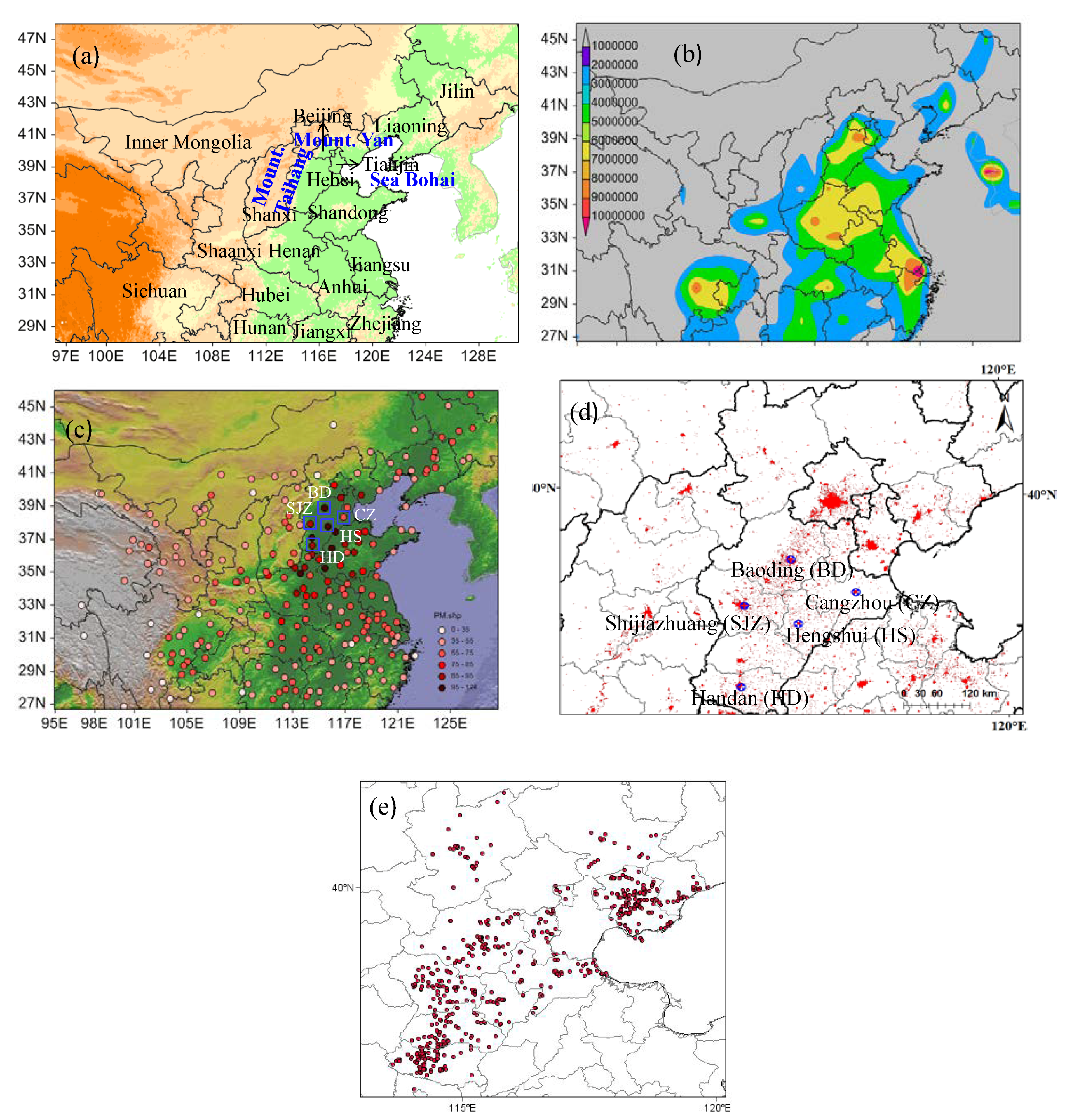

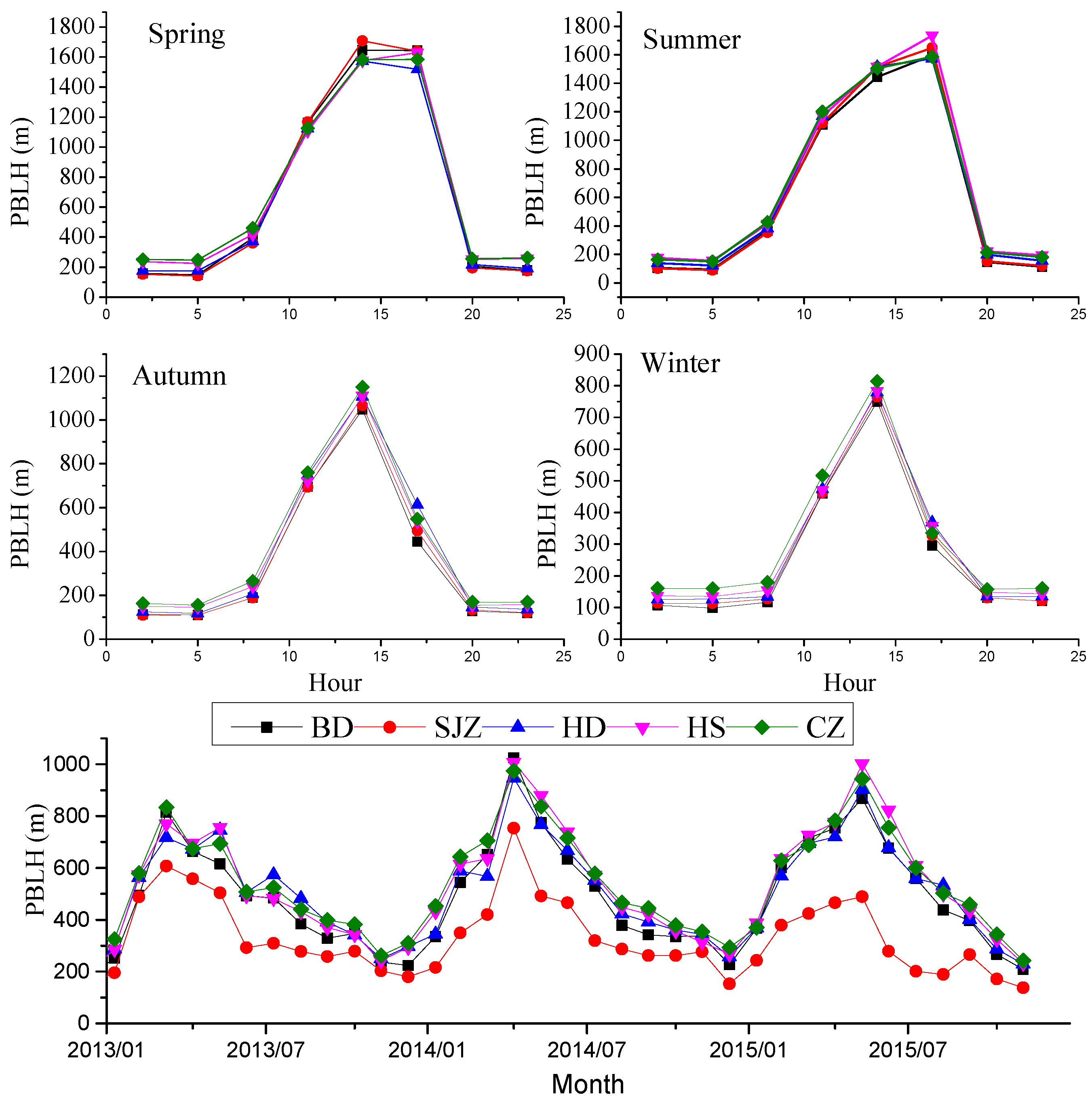


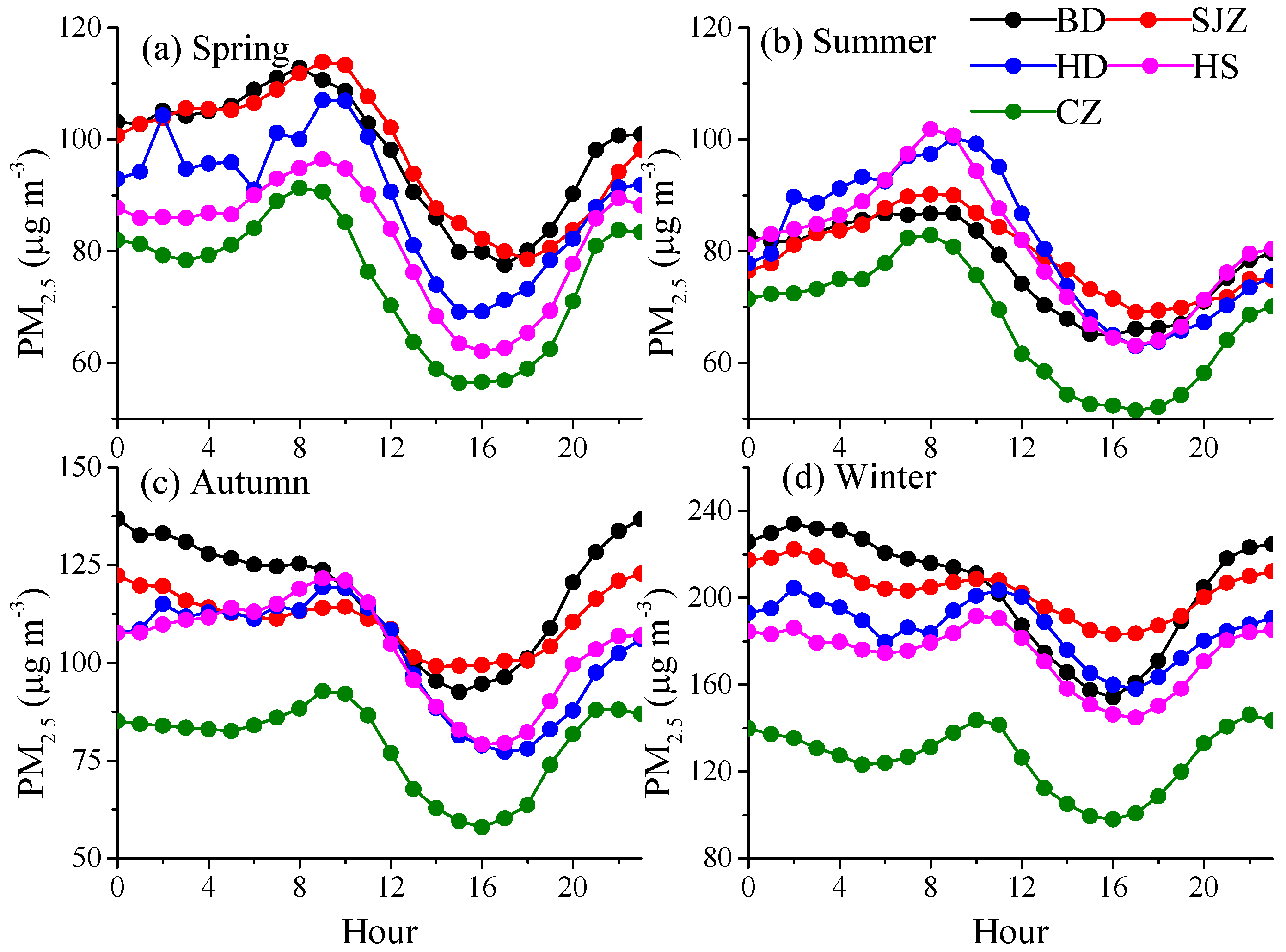


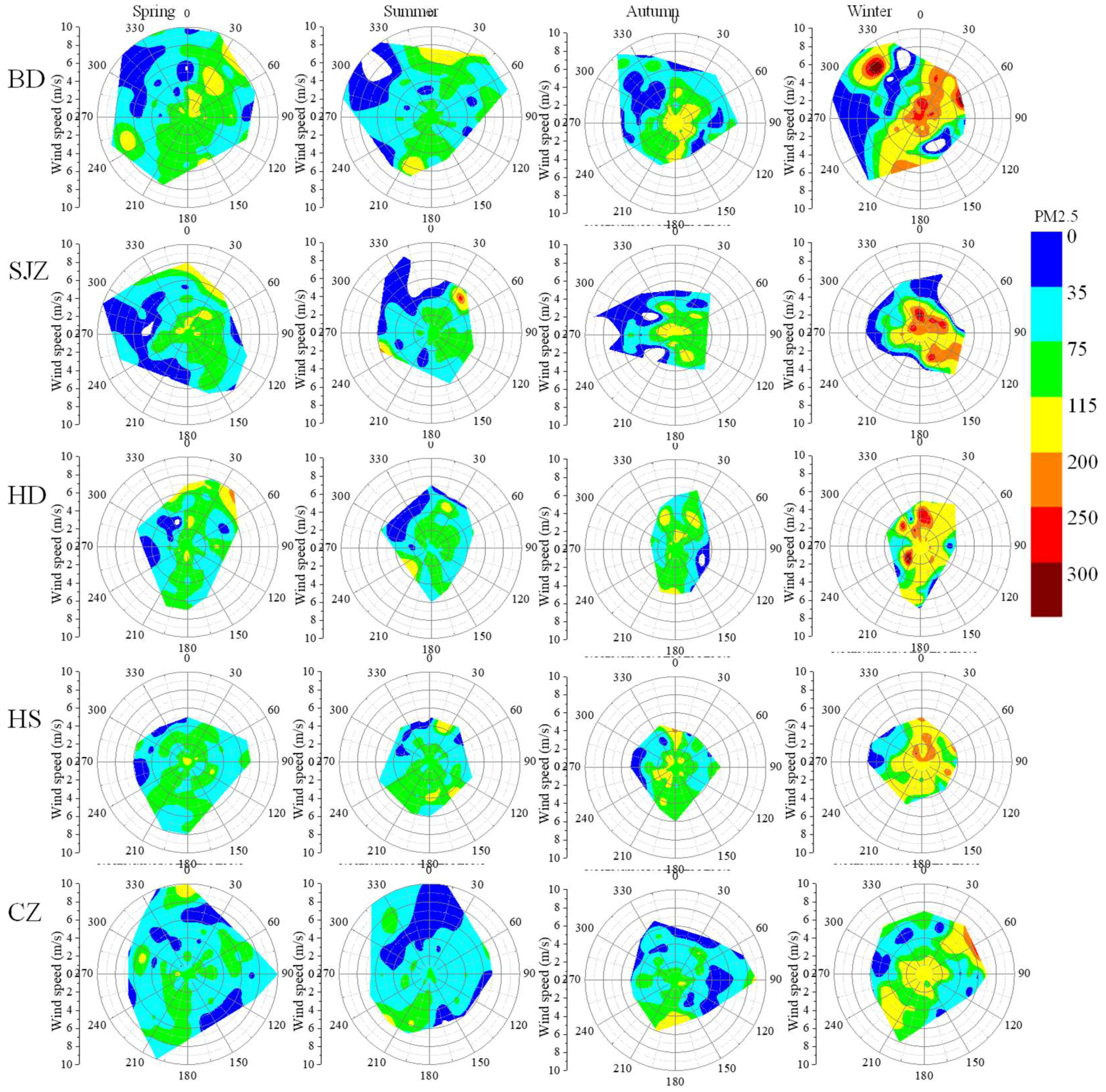
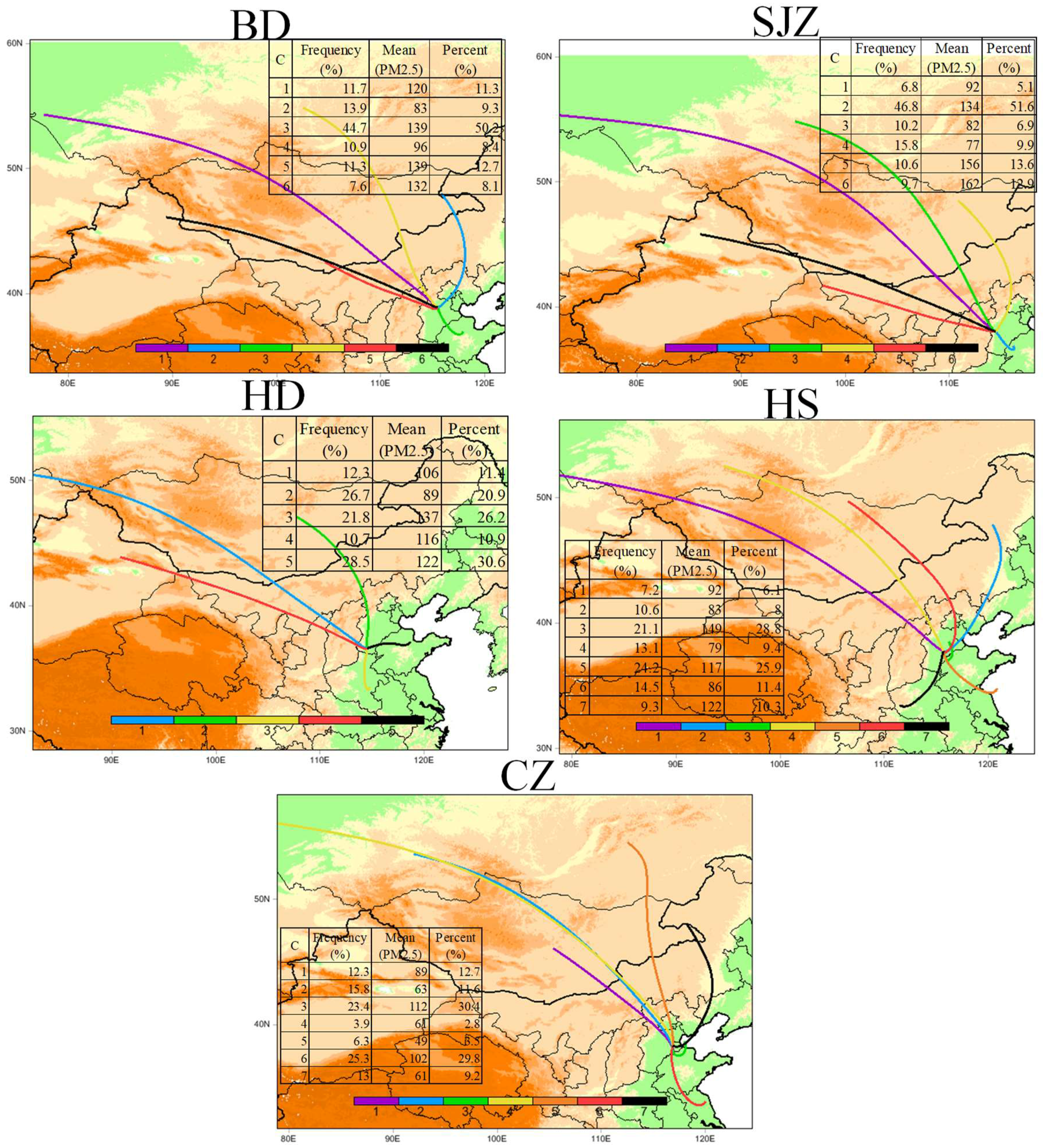
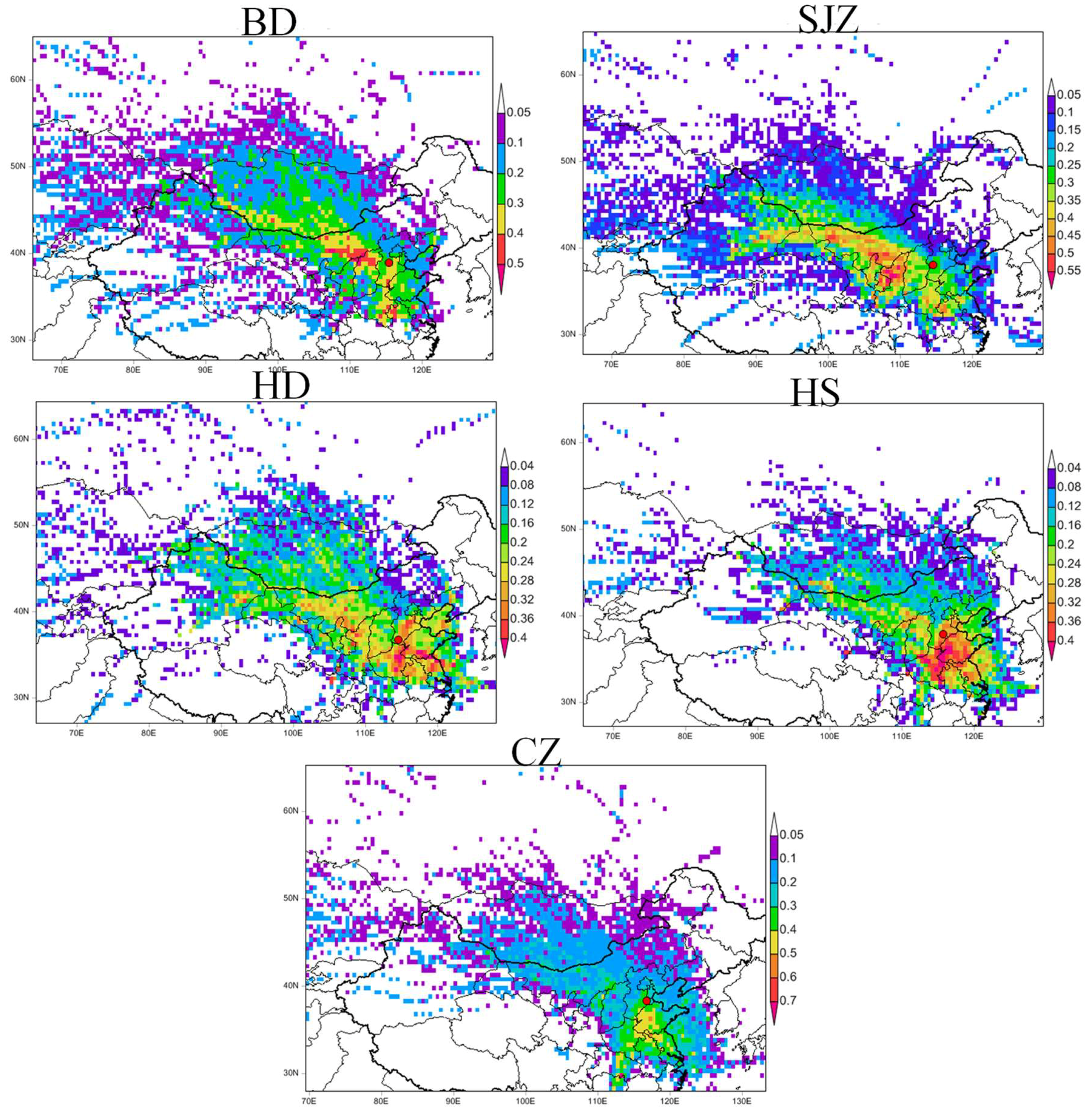
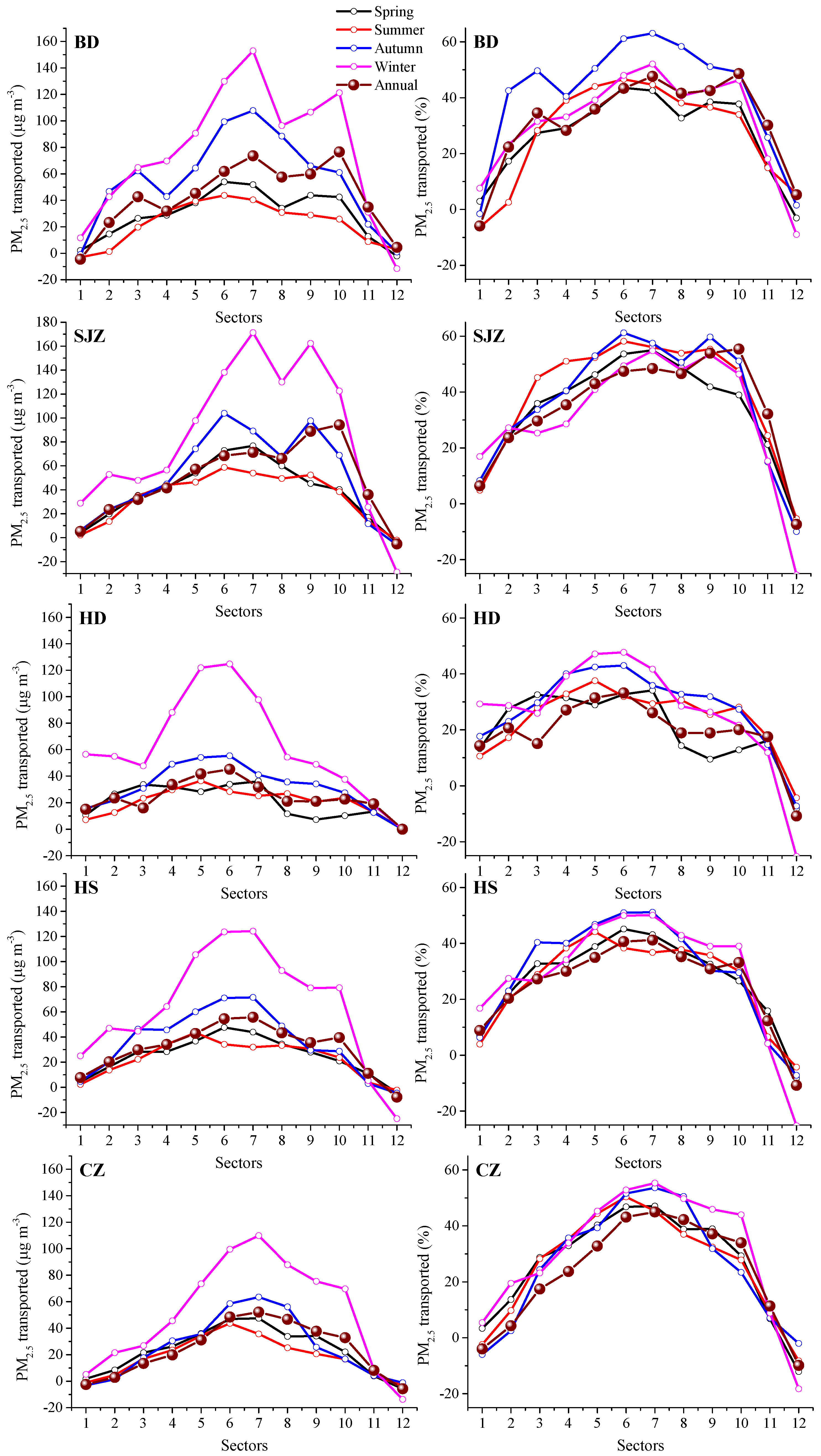
| Average ± Standard Deviations (SD) | Pearson Correlation Coefficient | % Exceedance Ratio (>75 μg m−3 (>250 μg m−3)) | |||||||||||||
|---|---|---|---|---|---|---|---|---|---|---|---|---|---|---|---|
| Annual | Spring | Summer | Autumn | Winter | BD | SJZ | HD | HS | CZ | Annual | Spring | Summer | Autumn | Winter | |
| BD | 123 ± 90 | 98 ± 51 | 78 ± 35 | 118 ± 91 | 203 ± 110 | 1 | 0.85 | 0.74 | 0.77 | 0.81 | 64.9 (9.3) | 62.9 (1.1) | 47.8 (0) | 61.2 (8.4) | 89.0 (28.5) |
| SJZ | 122 ± 101 | 97 ± 54 | 80 ± 45 | 111 ± 89 | 203 ± 141 | 0.85 | 1 | 0.87 | 0.83 | 0.82 | 60.8 (10.2) | 61.5 (2.2) | 46.4 (0) | 54.9 (8.8) | 81.4 (30.8) |
| HD | 114 ± 81 | 89 ± 39 | 82 ± 35 | 102 ± 61 | 185 ± 115 | 0.74 | 0.87 | 1 | 0.88 | 0.79 | 63.8 (6.5) | 58.2 (0.4) | 50.4 (0.4) | 61.2 (2.2) | 86.3 (24.0) |
| HS | 109 ± 77 | 82 ± 39 | 82 ± 36 | 104 ± 63 | 173 ± 110 | 0.77 | 0.83 | 0.88 | 1 | 0.86 | 60.2 (5.4) | 49.5 (0) | 50.4 (0) | 59.0 (3.3) | 82.9 (19.0) |
| CZ | 87 ± 58 | 75 ± 38 | 67 ± 33 | 79 ± 56 | 126 ± 76 | 0.81 | 0.82 | 0.79 | 0.86 | 1 | 48.1 (2.2) | 44.7 (0.4) | 36.6 (0) | 44.3 (1.1) | 67.7 (7.6) |
| Spring | Summer | Autumn | Winter | |||||||||||||||||
|---|---|---|---|---|---|---|---|---|---|---|---|---|---|---|---|---|---|---|---|---|
| RH | WS | T | Pre | Prep (Prior Day) | RH | WS | T | Pre | Prep (Prior Day) | RH | WS | T | Pre | Prep (Prior Day) | RH | WS | T | Pre | Prep (Prior Day) | |
| BD | 0.33 | −0.16 | −0.24 | −0.14 | −0.16 | 0.25 | −0.09 | 0.29 | 0 | −0.08 | 0.23 | −0.33 | −0.18 | −0.14 | −0.17 | 0.56 | −0.43 | −0.18 | −0.01 | −0.01 |
| SJZ | 0.4 | −0.24 | −0.15 | −0.08 | −0.15 | 0.35 | −0.19 | 0.02 | −0.02 | −0.16 | 0.27 | −0.29 | −0.16 | −0.17 | −0.2 | 0.56 | −0.29 | −0.3 | −0.03 | −0.05 |
| HD | 0.38 | −0.07 | −0.14 | −0.01 | −0.14 | 0.2 | 0.02 | 0.07 | −0.02 | −0.05 | 0.15 | −0.08 | −0.1 | −0.13 | −0.21 | 0.55 | −0.12 | −0.18 | −0.07 | −0.08 |
| HS | 0.37 | −0.15 | −0.06 | −0.09 | −0.11 | 0.29 | −0.01 | 0.13 | −0.04 | −0.11 | 0.28 | −0.15 | −0.06 | −0.07 | −0.22 | 0.58 | −0.26 | −0.08 | −0.04 | −0.06 |
| CZ | 0.35 | −0.1 | 0.05 | −0.01 | −0.09 | 0.13 | 0.16 | 0.19 | −0.03 | −0.16 | 0.22 | −0.13 | −0.2 | −0.09 | −0.15 | 0.54 | −0.28 | 0.02 | −0.07 | −0.07 |
| Concentration (μg m−3) | Percentage (%) | |||||||||
|---|---|---|---|---|---|---|---|---|---|---|
| Annual | Spring | Summer | Autumn | Winter | Annual | Spring | Summer | Autumn | Winter | |
| BD | 42.4 | 27.9 | 27.1 | 55.4 | 64.7 | 31.4 | 25.5 | 31.5 | 41.2 | 27.2 |
| SJZ | 46.4 | 35.0 | 35.0 | 45.9 | 64.4 | 33.7 | 31.3 | 39.9 | 34.1 | 26.5 |
| HD | 23.3 | 19.1 | 20.2 | 26.5 | 43.9 | 19.6 | 19.8 | 23.4 | 23.8 | 21.0 |
| HS | 30.2 | 24.4 | 26.1 | 35.9 | 51.9 | 24.8 | 26.5 | 29.8 | 29.4 | 24.0 |
| CZ | 21.6 | 22.5 | 24.0 | 24.9 | 39.6 | 20.2 | 25.1 | 32.0 | 24.5 | 23.8 |
© 2018 by the authors. Licensee MDPI, Basel, Switzerland. This article is an open access article distributed under the terms and conditions of the Creative Commons Attribution (CC BY) license (http://creativecommons.org/licenses/by/4.0/).
Share and Cite
Wang, L.; Li, W.; Sun, Y.; Tao, M.; Xin, J.; Song, T.; Li, X.; Zhang, N.; Ying, K.; Wang, Y. PM2.5 Characteristics and Regional Transport Contribution in Five Cities in Southern North China Plain, During 2013–2015. Atmosphere 2018, 9, 157. https://doi.org/10.3390/atmos9040157
Wang L, Li W, Sun Y, Tao M, Xin J, Song T, Li X, Zhang N, Ying K, Wang Y. PM2.5 Characteristics and Regional Transport Contribution in Five Cities in Southern North China Plain, During 2013–2015. Atmosphere. 2018; 9(4):157. https://doi.org/10.3390/atmos9040157
Chicago/Turabian StyleWang, Lili, Wenjie Li, Yang Sun, Minghui Tao, Jinyuan Xin, Tao Song, Xingru Li, Nan Zhang, Kang Ying, and Yuesi Wang. 2018. "PM2.5 Characteristics and Regional Transport Contribution in Five Cities in Southern North China Plain, During 2013–2015" Atmosphere 9, no. 4: 157. https://doi.org/10.3390/atmos9040157




